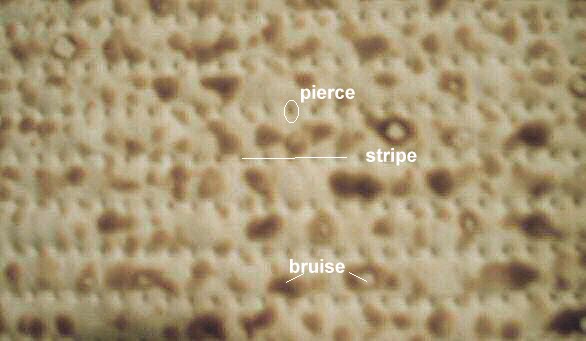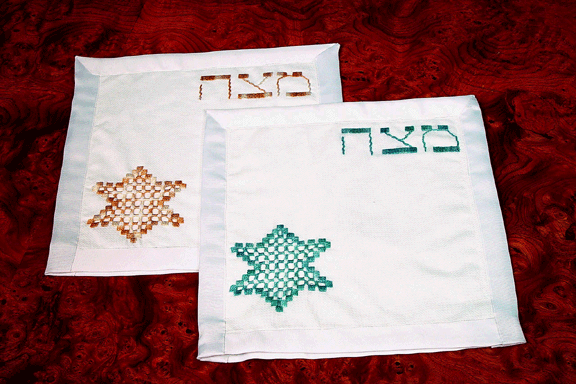 |
MessianicSeder.com |
 |
Here is a close-up picture of a piece of matzoh. It has a
lot of Messianic symbolism, discussed below.

-
The Bible tells us nothing about what Yeshua looked like—whether he was short, medium height or tall, whether he was thin, medium build or stocky, whether his face was round, elongated, somewhat angular . . .
- Yeshua described himself as food for the spirit—John 6:48 "I am the bread of life."
-
Realistically, the only portrait we have of Yeshua is in . . . the matzoh!
- Slaves getting ready to leave "at any moment" couldn't wait for dough to rise during baking, so matzoh is made without leaven—which in the Bible is symbolic of sin. Yeshua was sinless.
- Slaves on the run didn't have time to build ovens, so matzoh is cooked on a grill—which leaves lines . . . stripes.
- There is only flame on one side, so the cook pierces the dough as it's cooking, for more even heat.
- Where the flame touches or gets close to the bread it leaves darkened spots that look like bruises.
| |
Isaiah 53:5
But He was pierced for our transgressions,
He was bruised for our iniquities;
The punishment that brought us peace was upon Him,
And by His stripes we are healed.
|
-
Regarding the three matzot (plural of matzoh), they
are put in a 'bag' consisting of four squares of cloth. Picture four handkerchiefs
laid together and sewn on three sides. The result is a bag with three pouches,
one for each matzoh. This is referred to as a Matzoh cover or a Matzoh tash (rhymes with "posh"), the Yiddish word for pouch.

|

|
|
Above: One of thousands of different
square or round cover styles. A
matching Afikomen bag is sometimes
used (not shown).
Left: Side view showing three pouches
|
-
Keep in mind that this is a Messianic
Haggadah. The one Jesus (Yeshua) performed, which is still performed all
over the world by non-Messianic Jews, for the most part did not refer to
the Messiah.
-
Most of the parts that do not refer specifically
to the Messiah were and still are part of the non-Messianic
Seder also.
In other words, even though the Afikomen represents
the sinless, broken, bruised, whipped and pierced body of Jesus wrapped
in a shroud and hidden for three days, and even though traditional Jews
do not believe Jesus is the Messiah, still
they do those sections -- they don't understand the real symbolism of their
actions.
(The stripes are caused by preparing the matzoh on a
grill, because slaves on the run didn't have ovens. The flame leaves brown
spots that look like bruises. Because a grill only applies heat on one side,
holes are poked in the matzoh to allow more even heat flow during cooking.)
-
The recipies are the same as for traditional (non-Messianic)
Jewish Seders. They can be found in many books and at many websites.
        
Visit www.MessianicWorship.com
|